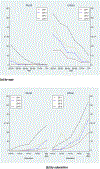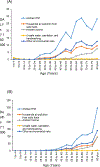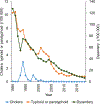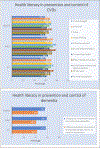The path to healthy ageing in China: a Peking University-Lancet Commission
- PMID: 36423650
- PMCID: PMC9801271
- DOI: 10.1016/S0140-6736(22)01546-X
The path to healthy ageing in China: a Peking University-Lancet Commission
Abstract
Around the world, populations are ageing at a faster pace than in the past and this demographic transition will have impacts on all aspects of societies. In May 2020, the UN General Assembly declared 2021–2030 the Decade of Healthy Ageing, highlighting the importance for policymakers across the world to focus policy on improving the lives of older people, both today and in the future. While rapid population ageing poses challenges, China’s rapid economic growth over the last forty years has created space for policy to assist older persons and families in their efforts to improve health and well-being at older ages. As China is home to 1/5 of the world’s older people, China is often held up as an example for other middle-income countries. This Commission Report aims to help readers to understand the process of healthy ageing in China as a means of drawing lessons from the China experience. In addition, with the purpose of informing the ongoing policy dialogue within China, the Commission Report highlights the policy challenges on the horizon and draws lessons from international experience.
The uniqueness of China’s ageing society: From a global perspective, China shares some of the economic and social challenges faced by other countries with rapidly ageing populations. China stands out, however, as it already has the world’s largest older population, and China’s ageing burdens will increase further as the ‘second baby boomers’ (those born between 1962 and 1975) start to enter retirement in 2022. In addition, China’s rapid demographic transition over the last four decades will lead to a dramatic decline in the number of living children for each older person in China and bring substantial challenges for both family-based care and social care. Compounding demographic changes, personnel planning in geriatric and rehabilitation medicine has not kept pace with the growth of the older age population, and there is a shortage of medical resources targeted at the ageing population. In Section 1, the report stresses the importance of achieving “healthy ageing” in light of socio-economic progress, urbanization and migration, and China’s demographic transition.
Health complexity and inequalities among China’s older population: China completed its epidemiological transition from infectious diseases to non-communicable diseases (NCDs) during the past three decades. As in many other ageing countries, the upward trend in the incidence of NCDs and the presence of multimorbidity pose special challenges for China’s healthcare sector. Even as some older Chinese continue to suffer from such communicable diseases as hepatitis, tuberculosis, and sexually transmitted diseases, chronic conditions, such as cognitive impairments, mental disorders, and frailty, are becoming much more prominent. These chronic conditions are complex to treat and manage and are associated with more functional disability and greater care needs. Along with the emergence of NCDs, substantial gaps in health are apparent by gender, rural versus urban residence, ethnicity, and socio-economic status. Investments in healthy ageing, from promoting education in health literacy to improving access to health care, are promising means of improving the well-being of older adults and reducing the gaps in health across socioeconomic groups in China. Even as China’s population ages, investments in healthy ageing offer a path for older Chinese to play meaningful and productive social roles in society, while limiting burdens on their families. The latest facts on health status and health inequities among China’s older adults are presented in Section 2 of the report.
Modifiable factors of healthy ageing: Evidence from China.: Current evidence on the determinants of health and functioning status of China’s older population is summarized in Section 3. In China, as elsewhere, health at older ages results from the cumulative effects of behaviours and events that occur across the life cycle. These include exposures to unhealthy environments and parental decisions influencing in-utero and childhood health, later health behaviours as teenagers and adults (including decisions on educational investments, smoking, drinking, and physical activity), and decisions over food consumption which influence diet and nutritional status. Many of these decisions and behaviors are influenced by health literacy and socio-economic conditions, but they may also be influenced by policy (Section 5). Finally, Section 3 highlights the health benefits of social connections and participating in leisure activities such as square dancing and promoting age-friendly environments in China.
Integrating medical and social care for Chinese older people.: Older people require access to high-quality health services that include prevention, promotion, curative, rehabilitative, palliative and end-of-life care. An update on China’s policy initiatives regarding healthcare and social care relevant to the ageing population is provided in Section 4. In addition to achieving universal health insurance coverage, China has invested heavily in public health promotion and the consolidation of the primary healthcare system. Further, as the role of the family in providing care for older people is eroded by dwindling family size and changing living arrangements, especially with the outmigration of adult children, China is taking steps to build up institutional and community care infrastructure as both a substitute for, and complement to, family care. Furthermore, long-term care insurance (LTCI) has been piloted in many cities as a financing mechanism. China’s experience with the LTCI pilots suggests that it will be difficult to sustain LTCI under the current pay-as-you-go framework, and that there will be a considerable public financial risk as the population ages. Although China’s government has placed the integration of health care with long-term care (LTC) at the forefront of its policy agenda, the progress for the integration has been slow.
Lessons learned from China and implications for the future.: An overview of the evidence presented earlier in the report is presented in Section 5, followed by policy recommendations for supporting healthy ageing in China. Policy recommendations outlined here can be generalized to other countries, especially low- and middle-income countries (LMICs). First, health promotion initiatives should focus on changing people’s behavior, especially smoking cessation, weight control, and health literacy education to reduce the incidence of NCDs and care burdens. Second, there is an urgent need to move away from disease-centred care to person-centred care and to increase the supply of health care workers, particularly in geriatric medicine, rehabilitation medicine, and hospice care. Third, innovative measures should be taken to remove obstacles to upgrading community and home environments and thus facilitate mobility and social engagement among older people.
There are several other policy areas that should be addressed, given China’s unique institutional environment. These include regional segmentation of health insurance systems and the regulatory environment for healthcare delivery. Specifically, the report suggests that policy in China should focus on: (1) national integration of the health insurance system to eliminate the current segmentation across regions and occupations; (2) capping regionally segmented LTCI initiatives, and striving for a national scheme that is independently funded; (3) switching government subsidies in the aged care sector from subsidising providers to subsidising consumers to facilitate market competition and to help existing care facilities to meet safety regulations; (4) strengthing the capacity to regulate medical service providers, especially in screening for fraud against the national medical insurance schemes and reforming the healthcare delivery sector by lowering barriers to entry and facilitating choice.
Older people are an important part of a family and an invaluable asset to society. Healthy ageing will not only enable older people to enjoy their later life to the fullest but has the potential to unleash the intellectual and vocational capacities of society as a whole. Recognizing that China’s older population will continue to grow, it is important to take their needs into account and prepare well in advance by creating an age-friendly environment for the ageing population. As China’s “second baby boomers” start to reach retirement age in 2022, it is imperative to take the window of opportunity afforded by China’s economic growth to make coordinated efforts across sectors to address the concerns of an ageing nation.
Conflict of interest statement
Declaration of interests We declare no competing interests.
Figures












Comment in
-
Towards healthy ageing in China: shaping person-centred long-term care.Lancet. 2022 Dec 3;400(10367):1905-1906. doi: 10.1016/S0140-6736(22)02361-3. Epub 2022 Nov 21. Lancet. 2022. PMID: 36423646 No abstract available.
-
Ending age discrimination and stigma to promote healthy ageing in China.Lancet. 2022 Dec 3;400(10367):1907-1909. doi: 10.1016/S0140-6736(22)02362-5. Epub 2022 Nov 21. Lancet. 2022. PMID: 36423649 No abstract available.
-
Insurance pools' merging in China needs careful design.Lancet. 2023 Feb 25;401(10377):641-642. doi: 10.1016/S0140-6736(23)00139-3. Lancet. 2023. PMID: 36841610 No abstract available.
References
-
- Kinsella K, He W. An aging world 2008. International population reports. Washington DC: US Government Printing Office, 2009.
-
- United Nations Department of Economic and Social Affairs Population Division. World Population Prospects; 2022.
-
- World Health Organization. World Health Organization’s (2015) World report on ageing and health World Health Organization. World report on ageing and health, 2015.
-
- Geriatric Medicine Branch of Chinese Medical Association, Editorial Office of Chinese Journal of Geriatrics. Healthy Standard for Chinese Elderly (2013). Chinese Journal of Geriatrics 2013; (8): 801.
Publication types
MeSH terms
Grants and funding
LinkOut - more resources
Full Text Sources
Research Materials
Miscellaneous

